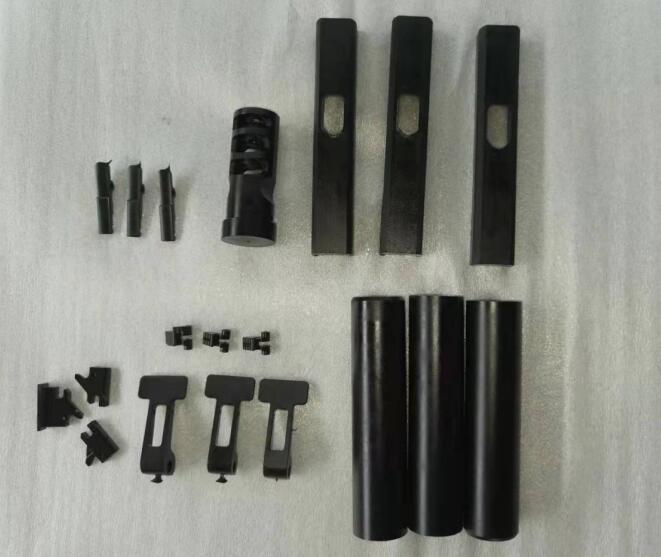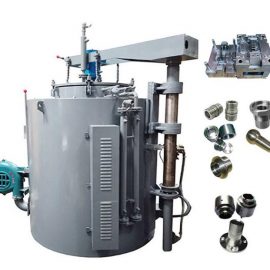QPQ Salt Bath Liquid Nitriding Process Quality Defect Analysis

Quality defects easily encountered in the production of QPQ salt bath liquid nitriding process and their causes are listed in the table:
| Item | Questions | Cause | Solution |
| 1 | Insufficient hardness (micro-hardness) | 1. The hardness measurement method is incorrect
2. The hardness measurement method is inaccurate, the surface is loose and not worn or worn too heavily, and the compound layer is worn away. 3. Low nitriding temperature or short time. 4. Nitride salt has low cyanate content. 5. The loose surface layer is too thick and the compound layer is too thin. 6. The pre-quenched hardness of high-alloy steel that requires high hardness is insufficient. |
1. Micro-hardness measurement must be used, Rockwell or other heavy-duty measurement cannot be used.
2. Before measuring the hardness, repeatedly test the weight of the abrasive paper to make it just right. 3. Check whether the process specification is appropriate and whether the process is strictly implemented. 4. Frequent testing of cyanate, and adding and adjusting salt according to regulations. 5. Thoroughly filter the residue. 6. Ensure pre-quenching hardness. |
| 2 | The seepage layer is thin or uneven | 1. Poor protection during sample preparation, and the compound layer peeled off.
2. The loose layer is too thick. 3. The surface of the workpiece is not completely degreasing or the surface is too dirty. 4. Low nitriding temperature, short time or low cyanate content |
1. Use a special fixture to press the stainless steel sheet to make samples
2. Thoroughly filter the residue 3. Thoroughly clean the surface of the workpiece, and hand wash if necessary. 4. Strictly implement the process and increase the cyanate content by adding adjusting salt. |
| 3 | The compound layer is severely loose (accounting for more than 1/2 of the total thickness) or delamination occurs | 1. Too much granular slag suspended in the nitriding salt bath
2. When the nitride salt is melted, the method of adding salt is incorrect or the furnace temperature is uneven, and the salt bath is locally overheated. 3. Nitriding time is too long 4. Nitriding temperature is too high |
1. First use the slag scoop to remove the residue, and then use the residue filter to filter the residue 2-3 times.
2. Strictly follow the operating procedures for the salt, and it is necessary to adjust the power of the electric furnace or the distribution of the furnace wire. 3. Appropriately shorten the nitriding time. 4. Lower the nitriding temperature. |
| 4 | Redness of the workpiece | 1. The oxidized salt is aging, and the salt contains a lot of Fe2O3.
2. After the workpiece exits the nitriding furnace, it stays in the oxidation furnace for too long. 3. The preheating time is too long or the preheating temperature is too high. 4. There is oxide scale or rust on the surface of the workpiece. |
1. Raise the oxidation salt to 320℃, keep it for 1 hour, remove the slag and add new oxidation salt before use.
2. After the workpiece is dripped with the nitride salt, enter the oxidation furnace as soon as possible. 3. Control the preheating temperature and time, the surface of the workpiece is blue-purple as well. 4. Carry out pickling or sandblasting in advance. |
| 5 | The surface color of the workpiece is uneven | 1. Oil stains and rust stains on the surface of the workpiece have not been completely removed.
2. Low preheating temperature or short time, overheating. 3. The workpiece does not gradually enter the oxidation furnace at a uniform speed, and it stops in the middle. 4. The oxidizing salt has aged, there is too much slag and the oxidizing salt is red. |
1. Thoroughly clean, remove oil, rust should be removed when there is rust.
2. Adjust the preheating temperature and time. 3. When the workpiece enters the oxidation furnace, enter the furnace at a uniform speed as much as possible under the condition that the smoke is not too large. 4. First remove the slag from the oxidation furnace, then raise the furnace temperature to 300°C, keep it warm for 2 hours before use. 5. Remove the scum on the salt bath noodles. |
| 6 | Large bending deformation of the workpiece | 1. After the workpiece has high machining stress or machining bending, there will be a large residual stress in cold straightening.
2. The way the workpiece is installed is incorrect. 3. Insufficient preheating. 4. After leaving the oxidation furnace, the cleaning is too early. |
1. Before the workpiece is processed, 600℃ stress-relieving annealing should be used to eliminate stress.
2. Slender pieces or thin plates should be installed vertically. 3. Increase the preheating temperature and extend the preheating time. If necessary, it can be preheated as the furnace heats up. 4. After the workpiece comes out of the oxidation furnace, cool it thoroughly and then clean it. 5. After QPQ treatment, if the workpiece is bent out of tolerance, it can be straightened by cold pressing, because the core of the workpiece is still in a plastic state. |
| 7 |
Excessive expansion and contraction of workpiece size |
1. Too much slag at the bottom of the nitriding furnace
2. Too much suspended slag in the nitriding furnace |
1. Use a slag spoon to remove slag thoroughly
2. Thoroughly filter the residue with a residue filter 3. A large number of experiments to find out the amount of expansion and contraction, and reserve a certain amount of expansion and contraction in advance. |
| 8 | Insufficient wear resistance during use of the workpiece | 1. Insufficient hardness of infiltration layer
2. The compound layer is too thin 3. The compound layer is severely loose 4. Improper selection of base material |
1. See serial number 1 of this table
2. See No. 2 in this table 3. See No. 3 in this table 4. If necessary, alloy steel or high alloy steel can be selected and pre-quenched |
| 9 | The workpiece has poor corrosion resistance | 1. The compound layer is too thin or uneven
2. The proportion of compound layer is too loose 3. The oxide film is incomplete. |
1. See No. 2 in this table
2. See No. 3 in this table 3. Properly extend the oxidation time |
| 10 | Little improvement in tool life | 1. The seepage layer is too shallow
2. Insufficient hardness of the matrix 3. Bad tool sharpening |
1. Properly extend the nitriding time
2. Improve the hardness of the matrix 3. Re-sharpening and processing |
| 11 | Tool use chipping | 1. The seepage layer is too deep or the compound layer is formed
2. Pre-heat treatment overheating 3. Insufficient pre-heating and tempering |
1. Appropriately shorten the nitriding time
2. Strictly control the quenching temperature 3. Extend the tempering time or increase the number of tempering |
Advantages of Strong Convection Full Hydrogen Bright Bell Annealing Furnace 20Cr2Ni4 Steel Gear Carburizing and Quenching Process Study Study On Annealing Process Of Ferro-Based Nanocrystalline Soft Magnetic Materials


Contact us
Your email address will not be published. Required fields are marked *